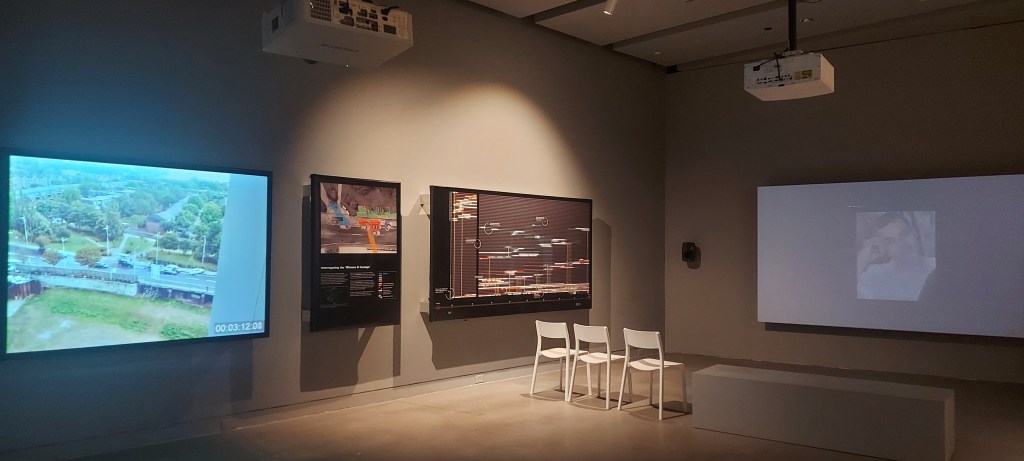
E Y E W I T N E S S
CAMP, Dries Depoorter, Forensic Architecture
Feb 5 – Apr 24, 2022
On a recent quick visit to Vancouver, I was fortunate to catch the tail-end of the fascinating exhibition Eyewitness at the New Media Gallery in New Westminster, near the city of Vancouver. I really like this gallery because it’s always innovative and presents something generally thought-provoking. ‘Eyewitness‘ presented three installation works on the theme of surveillance and they’re very different. All of them lead the viewer to think much more deeply about the surveillance society that we live in. Of course, we are very aware of the surveillance society; even the term “surveillance society” just slips off the tongue as though it means nothing. Though it scares us, we have accepted surveillance, and in that very acceptance we have lost any idea of what it actually means. In the hands of these artists, however, surveillance paranoia gives way to a much more thoughtful consideration of how surveillance can be turned back against oppression.

Forensic Architecture, based in the UK, publishes the results of their rigorous forensic process into the killing of Mark Duggan, a young black man who lost his life at the hands of the Metropolitan Police in Tottenham, north London, in 2011. During a “hard stop” when officers pulled out in front of Duggan’s speeding cab, ready for a confrontation, Duggan was shot close to the car. A handgun, said to be Duggan’s, was found in nearby bushes, apparently thrown there. But by whom? A subsequent investigation into the murder concluded that it was self-defence. A peaceful protest escalated into several days of violent rioting across London and beyond. Forensic Architecture re-investigates the incident, using footage captured by onlookers and publicly available records, leaving the viewer with many questions.
Indian collective CAMP pulls together diaristic CCTV film and audio documentation of people’s daily lives in Jerusalem neighbourhoods. It is a picture of life lived in low-key, permanent crisis.

Belgian artist Dries Depoorter connects publicly available emergency police calls in Seattle with the city-wide system of CCTV cameras. I’m very familiar with the city of Seattle, so it was interesting to see streets and neighbourhoods I know from the perspective of CCTV. The cameras record incidents as they happen, displaying the incident and the response.


Each work was shown in its own self-contained, immersive space and what I found interesting was the difference between the pacing and rhythm of each piece. Forensic Architecture’s work made me feel very on-edge and nervous. CAMP’s video is raw and unpolished, almost drab. It brings home the banality of constant surveillance in an oppressive situation and how essential it is to see it in action. And Depoorter’s – well I could have sat there all day. Actually, it was pretty interesting watching the shifting screens. Maybe I should change professions and become a CCTV op.
“But is it art’? I can hear people objecting to the show because frankly, it does not look like “art” in the traditional sense. And yes, I am more partial to paintings and drawings. BUT, and this is a big but, Eyewitness is necessary because it seems that only under title “art” do we actually get to think about these issues and address them thoughtfully. These are critical works, and they attest to the reality that art may be the only means of communication we have that allows us to consider problems without polemic.
Eyewitness is also a fascinating portrait of three modern cities from a perspective nobody ever considers. This is urban life as it is lived.
You must be logged in to post a comment.